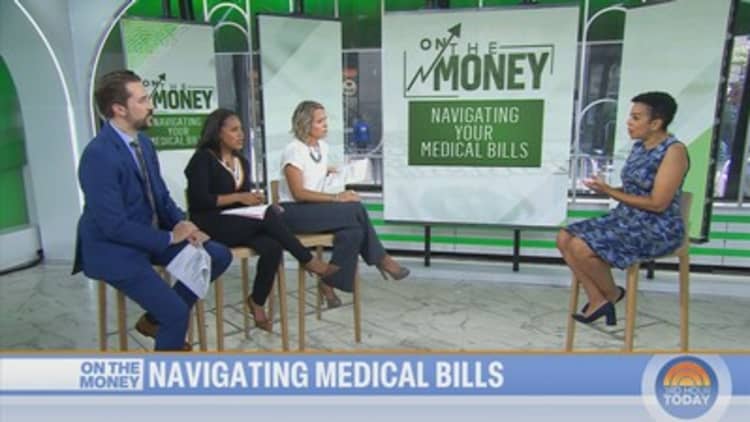



Unexpected medical bills can cost as much as $1,000 or more. Sometimes, these expenses are unavoidable. Still, you can take steps or ask questions of medical providers or your insurance company to avoid overpaying or getting saddled with charges you can’t afford to pay.
According to the Consumer Financial Protection Bureau, about $88 billion of outstanding medical bills showed up on consumer credit records in June 2021. This medical debt burden — affecting 1 in 5 Americans — is likely even higher, since not all medical debt is reported to credit reporting agencies.
”About 58% of all bills in collections and on people’s credit reports are for medical bills,” said Berneta Haynes, an Atlanta-based senior attorney with the National Consumer Law Center. ”Medical debt affects a broad range of people, but certain groups are more affected than other groups.”
More from Your Money:
Here’s a look at more stories on how to manage, grow and protect your money for the years ahead.
“Young adults, low-income folks, Black and Hispanic communities are more impacted, as well as veterans and older adults,” she added.
Learning how to manage medical bills can minimize your chances of getting into debt, so CNBC talked to experts about how to keep health-care expenses under control. Here are some steps they say you should take:
1. Don’t pay until you investigate
Medical bills are rife with errors. Numbers vary on this, but one study from Medical Billing Advocates of America estimates up to 80% of medical bills contain errors.
Older adults, for instance, may have multiple insurance carriers — Medicare as well as private insurance —and ”that can lead to an increased risk of billing errors and inaccurate bills,” Haynes said.
Also, be wary of collection notices. By law, debt collectors have to give people a letter or email with instructions on how to dispute the debt.

“If it doesn’t, that’s certainly a red flag that they may be dealing with a scammer,” said John McNamara, principal assistant director of markets at the CFPB.
2. Get an itemized bill
If you receive a bill from a health-care provider or insurance company and do not recognize the charge or service, contact the biller to request an itemized list of services and providers of your care. You may be able to log into an online account and review a digital bill if you no longer get paper statements.
If a hospital or provider seems hesitant to send an itemized bill, remind them that you are guaranteed under federal law — HIPAA, the Health Insurance Accountability and Portability Act — to get one.
3. Cross-check bills with an ‘explanation of benefits’
An “explanation of benefits” document comes from the insurer and may look like a bill — but it is not. The EOB outlines how much your health-care provider is charging your insurer, how much the insurer will pay and how much you have or may have to pay. This amount is usually your co-pay, deductible or any other balance due.
Contact your health-care provider if there are discrepancies between what the EOB says you should owe and your itemized bill.
4. The new No Surprises Act should help
Historically one of the biggest causes of large, unexpected medical bills was a case like mine where an out-of-network provider was involved in your care — often at a hospital — without you realizing it.
About a month after having emergency surgery to repair a sudden, life-threatening brain aneurysm rupture several years ago, I received a “surprise bill” for care from a specialist in the operating room who was not in my insurance company’s network. A friend helped me appeal the charge, indicating I did not have a choice of who was in that room saving my life. Eventually, the insurance company paid the charge — but it took time and effort.
Medical debt affects a broad range of people, but certain groups are more affected than other groups. Young adults, low-income folks, Black and Hispanic communities are more impacted, as well as veterans and older adults.
Berneta Haynes
senior attorney with the National Consumer Law Center
In 2022, a new law aimed at reducing “surprise bills” for emergency services went into effect. Under the federal No Surprises Act, excessive out-of-pocket costs are restricted and emergency services must continue to be covered without prior authorization, regardless of whether a provider or facility is in-network. Although that law is facing legal challenges, the Center for Medicare & Medicaid Services, or CMS, is still accepting consumer complaints. You can file a complaint here or call 1-800-985-3059.
5. Review billing codes
If you believe you received a bill in error or your insurance company didn’t pay the correct amount, scrutinize the billing codes on the document. Your itemized bill will list current procedural terminology, or CPT, codes for medical services or treatments provided.
These CPT codes are used to describe health-care services and procedures and are used by health insurance and health-care providers. Ensure the services you received align with the CPT code on the bill. You can often look up what the code stands for online.
6. Verify a claim was submitted
You want to make sure the medical provider or facility submitted a claim under your current health insurance plan, especially if you recently changed jobs or insurers.
If a health-care provider is considered “in-network” for your plan, then the provider has negotiated a discounted rate with your insurance company, so you’ll typically end up paying less by going to providers in your network than to an out-of-network provider.
Also, contact the provider directly if you don’t think you owe the debt. “Providers hire debt collectors to do this work for them,” McNamara said. “But that doesn’t mean providers won’t talk to a former patient if there’s a problem.”
7. File an appeal
If your insurer won’t pay the claim or will only pay part of the claim and you think it should be covered, you have the right to appeal.
”Keep great records and a journal of the steps you’ve taken, who you talked to, when and what they said,” said certified financial planner and physician Carolyn McClanahan, founder of Life Planning Partners in Jacksonville, Florida, and a member of CNBC’s Advisor Council. “If you are not getting relief from the provider and you know the bill is wrong, file an appeal with your insurance company and contact your state insurance commissioner.”
While challenging medical bills can be time-consuming and frustrating, don’t be intimidated by the idea of appealing a medical bill. “It’s actually very important not to overthink the formal appeal process,” said Haynes at the National Consumer Law Center. “It really can be as easy as calling up your insurance company.”
8. If you do owe, negotiate for a lower bill
If the cost of the care you received was higher than you expected, contact the health-care provider or the hospital and ask to negotiate. Reach out and tell the provider that you can’t afford to pay the bill and offer to pay a lower lump-sum amount.
If you’re being charged $1,500 for a procedure but you found out the rate in your area is generally $1,000, look at your finances. If you can afford to pay $1,000, offer that lump sum to wipe out the bill.
”It can be surprising how often providers will accept a lower lump-sum amount just to get rid of the debt,” Haynes said.
9. Request a payment plan
Hispanolistic | E+ | Getty Images
If you can’t afford a lump-sum payment, then work with your medical provider or biller to come up with a payment plan. Make sure you agree to monthly payments that you can truly afford to make regularly.
”Work directly with the medical biller or provider to set up an interest-free payment plan,” said Bruce McClary, senior vice president of the National Foundation for Credit Counseling. ”Talk to a nonprofit credit counselor to understand your options if you’re lost and want a clear understanding of the choices.”
10. Use HSA money
Health savings accounts can help you pay for unexpected medical bills. You set aside a portion of every paycheck to fund these tax-advantaged accounts, which are paired with a high-deductible health insurance plan. Funds can be carried over year to year. You can use HSA funds for health-care services and treatments as needed or keep the money invested for your medical needs down the road.
11. Look into need-based assistance programs
You may qualify for Medicaid, subsidized insurance or charity care programs. There are federal requirements for nonprofit hospitals to provide financial assistance programs for low-income patients. The aid varies depending on the state and the institution. Ask the provider or facility what they may offer.

12. Avoid paying with credit cards
The average interest rate on credit cards is nearly 25% — and is even higher for some ”medical credit cards.”
If you pay for a large medical bill with a credit card, use one that has a 0% interest introductory offer for at least 12 to 18 months — but be sure to pay the balance in full before the promotional offer ends.
”You don’t want to add more cost to the repayment of a medical bill, so don’t move the debt to a loan or line of credit with high interest,” McClary said.
— CNBC’s Stephanie Dhue contributed to this story.
LEARN MORE: Sharon Epperson is a brain aneurysm survivor. September is Brain Aneurysm Awareness Month. Find out more about this disease at bafound.org.
[ad_2]
Source link













